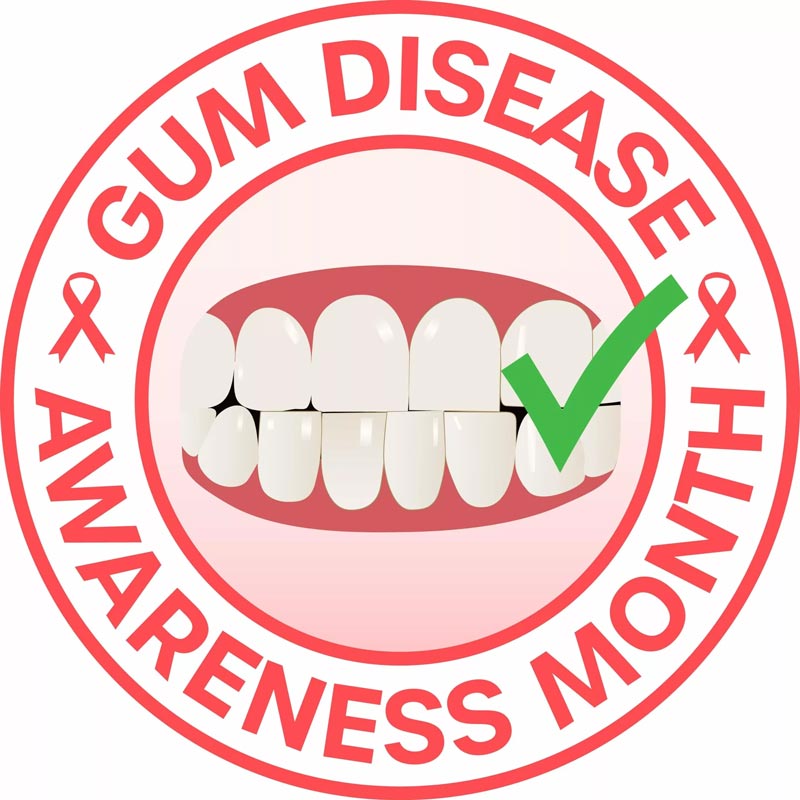
Most people know the importance of preventing tooth decay, but there isn’t as much conversation about gum disease prevention and treatment. The truth is that the health of your gums is just as important as your tooth health. The gums act as a foundation to hold the teeth in place, which is why it’s essential for every patient to know about habits to care for their gum health.
The month of February has been designated as gum disease awareness month. So, it’s the perfect time to learn more about gum disease and how you can protect your smile.
Gum Disease: What You Need to Know
Gum disease, also known as periodontitis, is a dental condition caused by an infection in the soft tissue surrounding the teeth. Bacteria can grow under the gumline, resulting in pockets of infection that can result in serious damage if left untreated.
Not only is the soft tissue affected by the infection, but untreated gum disease can also destroy the bone that is supporting the teeth. As a result, the damaged tissue and jawbone no longer provide a solid foundation for the teeth, resulting in teeth that start to loosen. Eventually, tooth loss can occur.
When gum disease is diagnosed and treated in the earliest stages, then it is possible to avoid these serious side effects.
Watch for These Symptoms of Gum Disease
The color, texture, and overall feeling of your gums are good indicators to help you identify whether you have gum disease. Healthy gums fit around the teeth snugly. They are firm and have a pale pink color. If you have periodontal disease, then you likely have some or all of these symptoms:
- Bleeding gums
- Swollen or puffy gums
- Gums are tender or painful to the touch
- Your toothbrush is pink after brushing
- Spitting out blood when flossing or brushing
- Pain when chewing
- More space between the teeth
- Gum recession
- Pus between the gums and teeth
- Bad breath
- Loose teeth
- Tooth loss
If you notice any of these symptoms, then it’s important to talk to a dentist without delay. Our team offers a variety of treatments to stop the infection and prevent additional complications from gum disease.
What Causes Gum Disease?
There are several stages in which gum disease starts and worsens. First, a sticky film is present on the surface of your teeth and near the gums, known as plaque. This film is composed of bacteria that can cause infection and tooth decay. Brushing and flossing regularly is important to remove this film.
The plaque formation happens because of the way sugar and starch interacts with the bacteria in your mouth. Even though you brush your teeth, the plaque starts to form again quickly. Which is why regular brushing and flossing is essential.
When the plaque is left in place, it can start to harden under the gumline. This hardening is known as calculus or tartar. This hardened buildup is more difficult to remove – your toothbrush won’t scrub it away. The longer plaque stays on the surface of the teeth, the more damage can occur. The only way to remove plaque is with a professional dental cleaning.
Gum Disease Awareness: Early Stages Leading to Advanced Symptoms
Plaque leads to the development of gingivitis, which is the first stage of gum disease. The gums become inflamed and irritated, which starts to affect the gingiva (located at the base of the teeth). At this stage, gum disease awareness is essential so you can implement consistent oral care at home, as well as professional treatment as needed.
For example, if you improve your brushing and flossing habits in the early stages of gum disease, then it’s possible to stop the symptoms and prevent complications.
As the infection develops, then more serious forms of gum disease can set in. For example, ongoing gum disease causes periodontitis. At this stage of gum disease, there are pockets between the teeth and gums that are filled with bacteria, plaque, and tartar. Over time, the pockets get deeper and continue filling with more bacteria.
When left untreated, the deep pockets of infection result in a loss of soft tissue and bone. Not only are you at risk of bone loss, but the chronic inflammation can also take a toll on overall immune health because the immune system is constantly fighting against the ongoing infection.
Prevention Is Always Best
As with many other health concerns, prevention is the best solution to avoid complications from gum disease. Don’t wait until the symptoms appear and worsen. Instead, there are simple things you can do at home to avoid gum disease altogether.
Gum disease awareness focuses on helping people of all ages implement preventive dental care early, and maintain consistency in their at-home flossing and brushing.
There are two important elements to prevent gum disease and catch potential symptoms in the earliest stages:
- At Home Care: The foundation of healthy gums starts with brushing your teeth twice a day. The ideal schedule is when you wake up in the morning, and again before bed. Additionally, everyone should floss a minimum of one time per day. Floss before you brush your teeth, then the brushing will clean away the bacteria and particles that are loosened with the floss.
- Regular Dental Cleanings and Checkups: Next, make sure you are consistent about visiting the dentist regularly. The ideal schedule is twice a year. Or, your dentist might recommend appointments more frequently if you have any conditions that increase your risk for gum disease or complication, such as the use of certain medications, smoking, diabetes, cancer treatments, and more.
Treating Gum Disease
Rest assured knowing that treatments are available if you are diagnosed with gum disease. For example, scaling and root planing are deep cleaning treatments that remove bacteria and tartar from under the gum line.
Additionally, oral or topic antibiotics might be recommended to target the infection. For example, the dentist might place gel antibiotics into the pockets of infection.
In severe situations, gum surgery might be necessary to clean the area and graft in bone and/or soft tissue.
Talk to Our Team for More Information
Do you want to learn more about gum disease awareness and protecting your smile? Our team is always here to help. Contact Cosmetic & Family Dentistry of Las Colinas to schedule a checkup and consultation.
- Awareness16
- Bad Breath1
- Bone Grafting1
- Braces4
- Causes, Symptoms, And Treatments6
- Cavities5
- Chewing Gum1
- Cosmetic Dentistry of Las Colinas15
- COVID-192
- Deep Cleaning7
- Dental Anxiety1
- Dental Bridge2
- Dental Care27
- Dental Cleaning6
- Dental Crown1
- Dental Filling1
- Dental Health24
- Dental Implants6
- Dental Sedation1
- Dental Visit1
- Dental X Ray3
- Floss1
- Gum Dieseases4
- Injury1
- Insurance1
- Invisalign8
- Oral Cancer1
- Oral Hygiene24
- Root Canal9
- Sleep Apnea2
- Tartar1
- Teeth19
- Thanksgiving1
- TMJ1
- Tongue1
- Veneers2
- White Teeth12
Get Your Best Smile With Us
